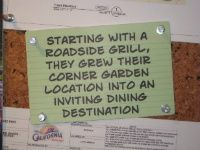In Disney's California Adventure amusement park, there is an attraction called Walt Disney Imagineering Blue Sky Cellar. The attraction provides ". . . a rare preview of upcoming magic through the eyes of Walt Disney Imagineers at Disney California Adventure Park," through illustrations, models, maquettes, and video interviews with the people who create the rides and other attractions of the Disneyland Resort.
One example of the Imagineering process describes planning a restaurant in California Adventure.
This is where the designers begin. With the backstory. For a restaurant.
Living in southern California means easy access to lots of amusement parks. We purchased annual passes for Disneyland for the last three years, and this year we also bought passes for Universal Studios Hollywood. Both California Adventure and Universal Studios offer river-raft attractions: Grizzly River Run at Disney and Jurassic Park - The Ride at Universal.
GRR (grr . . . like a bear, get it?) simulates a river-rafting trip in northern California; Jurassic Park simulates an attraction in, well, Jurassic Park. Both rides attempt to create a believable environment for visitors, and both attractions offer an thrill ride where the riders are assumed to get soaked to some degree - in fact, both rides go out of their way to make sure you get wet.
After riding both rides numerous times, I've noticed a distinct difference between the two attractions with respect to that last feature. On Jurassic Park, the ride begins with a trip through a dripping rainforest canopy, then passes along an Isla Nubar river; along the way, water squirts from behind bushes or from the mouths of the fringed dinosaurs to get the riders wet. After the final plunge, water mortars shoot a spray of water into the air as the raft reaches the bottom of the drop, pretty much guaranteeing a soaking.
On GRR, however, the riders are sprayed by leaking pipes in an old mill, by a waterfall inside a cave, and by a leaking log flume. There are no water cannons at the bottom of the plunge on GRR; instead you find yourself carried into the path of a geyser which jets water over the raft.
Now here's the thing: in addition to creating an environment and telling a story, both rides do their best to soak their riders, but GRR takes that a step further by making the soaking a natural extension of the ride environment and the story instead of simply adding squirting jets and water cannons to the experience.
Both rides deliver the watery thrills you expect them to, but the Disney attraction seamlessly integrates those thrills with the imaginary environment.
I think about gaming quite often when I'm at Disneyland; I never fail to be blown away by the attraction designers' ability to pull me into the environment.
And where do they begin? With the backstory. Even for something as mundane as a burger joint and a pizza parlor.
I agree with the notion that, all else being equal, a '"pretty" dungeon' - an adventure site which possesses a backstory and an a mix of design aesthetics - is better than one without.
I know some gamers couldn't care less; they're in it for the action, and aesthetics and (most especially) backstory may not enter into that for them. This is where the "all else being equal" enters into the equation; like GRR and Jurassic Park riders want to get wet, roleplaying game players want an environment which lends itself to action. "Pretty" dungeons can't just be pretty - they need to offer that action as well.
I put together a description of a tavern for my Flashing Blades game. The backstory is that the "Sail-Needle" was once a sail loft before being converted into a tavern. The structure has high ceilings, reflecting its earlier use in manufacturing sails for the galleys and roundships of Marseille.
So what, right?
Because those ceilings are so high, the tavern has two large chandeliers to provide light for the guests. This provides the opportunity for a classic staple of cape-and-sword adventure, the chandelier swing, not only from a single chandelier, but rather a pair of them. In this example, the backstory plays directly into creating an environment conducive to action appropriate to the swahbuckling genre.
For some gamers, perhaps many gamers, things like aesthetics and backstory, the stuff that makes an adventure location "pretty," may make little difference, but, in my experience, for the gamers who appreciate them, putting in the effort to make the environment meaningful really enhances the experience of playing the game.




Backstory and subtext explained. Nice post :)
ReplyDeleteI resisted going to any Disney park for years, but when I finally caved in, I was awestruck by the amount of detail and thought that went into it.
My English cousin and her family said there's nothing like it in the UK.
DeleteI've never thought of it as "backstory" before, but I agree, it's a really important element.
ReplyDeleteVery interesting!
ReplyDeleteAhoy Cap,n, first time visitor and great to meet you! We have annual passes to Disneyland and will be going today if the rain lets up. And great post on backstory and good luck with Flashing Blades!
ReplyDeleteAn interesting explanation of backstory. I am a new follower from the challenge.
ReplyDeleteAbsolutely agree with this. I always consider the successive people who've lived in or used a place, particularly when designing a dungeon.
ReplyDeleteThere are so many great ideas that suggest themselves from thinking the history of location through.
DeleteIntriguing! This is a whole world that is completely new to me.
ReplyDeleteI'm popping in visiting random blogs that catch my eye from the A to Z Challenge list. I've never been to Disneyland.
ReplyDeleteI enjoyed your list of Scottish jokes!
DeleteI'd love to see a clever double-chandelier swing stunt in a swashbuckling film.
ReplyDelete